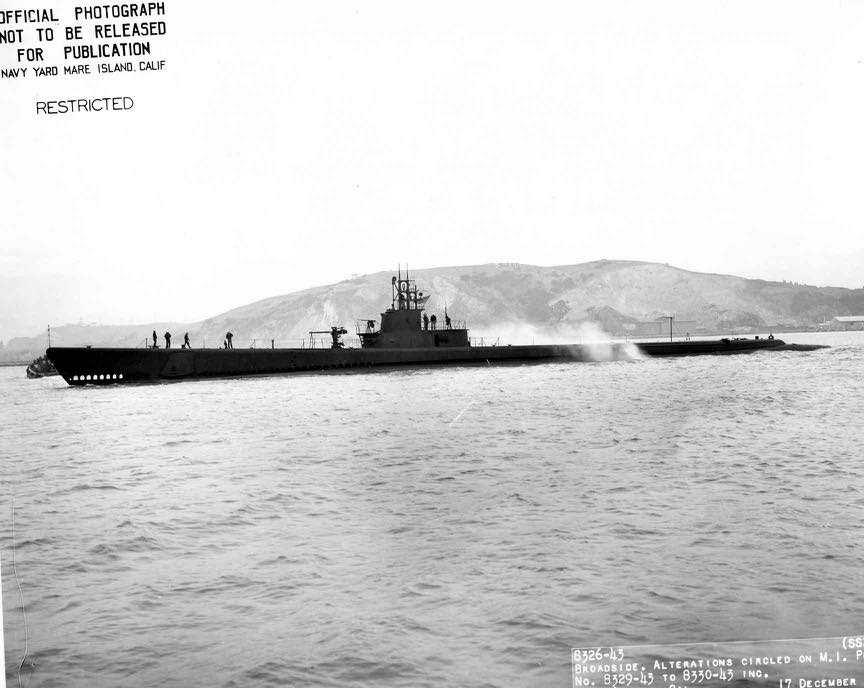Jack SS-259

Jack I
(SS-259: dp. 1,526; 1. 311'9"; b. 27'3"; dr. 15'3"; s. 20
k.; cpl. 60; a. 10 21" tt., 1 3", 2 .50 car., 2 .30 car.; cl.
Gato)
The first Jack (SS-259) was launched by Electric Boat Co., Groton, Conn., 16 October 1942; sponsored by Mrs. Frances Seely; and commissioned at New London, Conn. 6 January 1943, Comdr. T. M. Dykers in command.
Jaek underwent shakedown training along the New England coast, sailing from New London 26 April 1943 for service in the Paciflc. Reaching Pearl Harbor 21 May the submarine took on supplies and departed on her flrst offensive war patrol 5 June 1943. Taking part in a submarine offensive against Japan, she patrolled off Honshu. Jaek came upon a five-ship convoy 26 June and in a series of five well-executed attacks sank 4,000-ton passenger-cargo ship Tollo Maru and 6,000-ton cargo ship Shozan Maru. In attempting to torpedo a third ship, the submarine was shaken by an aerial torpedo; but the alert crew corrected her dangerous diving angle and effected repairs. On Independence Day 1943, Jack began to track smoke on the horizon and soon detected NikkyoMaru with an escort. The submarine sent the cargo ship under with
three torpedoes and returned to Pearl narbor for repairs 19 July 1943.
Jack's second war patrol (5 September-10 October) brought no opportunities for attack as engineering difflculties forced her to return prematurely to Pearl Harbor.
On her third war patrol the submarine proceeded westward from Pearl Harbor to the South China Sea 16 January 1944. Prowling the pivotal Singapore-Japan shipping lanes, she encountered five large oil tankers with three escorts early 19 February. Jack reached attack position at about 0440 and fired three torpedoes, scoring one hit. She then began a long circling maneuver designed to bring her in front of the remaining four tankers, and late in the afternoon of 19 February she was again ready to attack. Two torpedoes sank two more of the frantically zigzagging ships, and Jack moved in on the trailing tanker. Her flrst spread of torpedoes missed and the tanker replied with a 5" salvo; but Jack returned 3 hours later to sink her with four well-placed torpedoe.s. In this remarkable series of attacks the submarine sank four tankers, all over 5,000 tons—Rokuie Maru, Nanei Maru, Nichirin Maru, and Ichigo Maru. After several more attacks Jack set course for Fremantle, Australia, her new base, where she arrived 13 March 1944.
Departing Australia 6 April 1944, Jack returned to the South China Sea for her fourth war patrol. She chased a long convoy through the afternoon of 25 April, and shortly after midnight next day attacked, sinking Yoshido Maru and damaging two others. She also sank a radio-equipped trawler, Daisun, 27 April with gunfire before returning to Fremantle 10 May 1944.
Jack steamed out of Fremantle for her fifth war patrol 4 June 1944, again returning to Japan's important lifelines in the South China Sea. Early 24 June she made an approach on a large convoy and fired three torpedoes, sinking a large tanker, San Pedro Maru, before being forced to retire by escorting aircraft. Five days later she came upon another large convoy, and by early 30 June was in a position to attack. Three successive attacks sent cargo ships Matsukawa Maru and Tsukushima Maru to the bottom. Jack returned to Fremantle 14 July 1944. For her highly successful and aggressive flrst, third, and fifth war patrols, the submarine was awarded the coveted Presidential Unit Citation.
The submarine turned to the Celebes Sea for her sixth war patrol, and sailed 6 August 1944. Attacking a convoy 28 August, she sank a small minesweeper and started in pursuit of a cargo ship. After her torpedo missed and she was raked with gunfire by her adversary, Jack deftly evaded the attacker and returned later to sink the Japanese ship, Me`rico Maru. She arrived Fremantle following this patrol 24 September 1944.
Jack sailed from Fremantle once more 27 October 1944, bound for the South China Sea. She attacked a coastal convoy 14 to 15 November, sinking cargo ships Nichiei Maru and Yuzan Maru before shallow water forced her to break off the flght. The attrition of Japanese shipping was beginning to tell; and the ship found no more opportunities before ending her patrol at Pearl Elarbor 24 December 1944. From there she returned to San Francisco for a mayor overhaul.
The veteran submarine returned to Pearl Elarbor
April 1945, and departed on her eighth war patrol 26 April. With most Japanese shipping sunk or reluctant to venture into the sea lanes, her major job was to act as lifeguard for the massive carrier strikes and bomber missions on the Japanese mainland. The submarine returned to Guam for reflt 18 June and set out again 12 July for her ninth and last war patrol. Stationed between Luzon and Okinawa, she again performed lifeguard duty until the Japanese surrender 15 August 1945. Iler ninth patrol ended at Midway 29 August.
Jaok sailed for the United States 5 September 1945, steaming via Pearl IIarbor and the Canal Zone to New York 3 October 1945. She decommissioned at New London 8 June 1946, and was placed in the Atlantic Reserve Fleet. She recommissioned briefly 20 December 1957, to prepare for transfer to the government of Greece and
after training operations was loaned to the Royal Hellenic Navy 21 April 1958. She serves as HUMS Amfitriti ( S-O9).
In addition to her Presidential Unit Citation, Jack received seven battle stars for World War II service. All patrols, except for her second and ninth, were designated successful.
